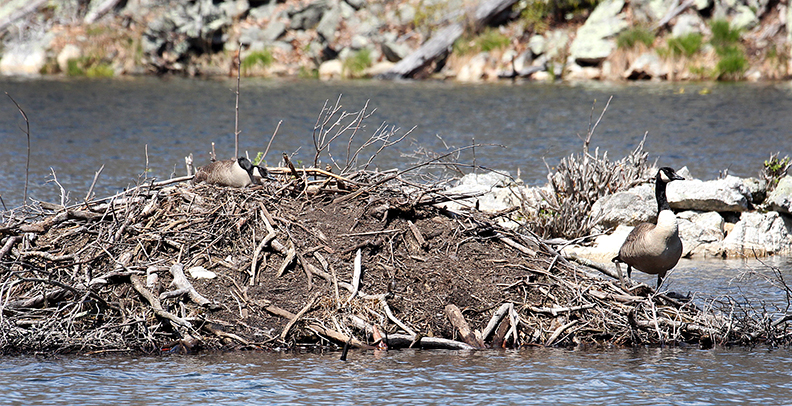Canada Geese & Beaver Dens

PHOTO: A Canada goose sits on a nest atop a beaver den as another goose remains alert to potential danger in New England this spring. Chris Bosak Photo

by Chris Bosak
Weirs Times Columnist
I received an interesting email the other day from Tricia from Alstead. She relayed that she and a few other people — and a couple of dogs — were taking a walk when they noticed a strange lump on the top of a beaver den.
It turned out that the lump was a Canada goose, presumably sitting on eggs, as the bird remained hunkered down, despite the proximity of the humans and dogs. Tricia hypothesized that the goose nest was built over a vent hole in the den, which kept the eggs warm.
I couldn’t confirm nor deny that hypothesis but it does make sense.
The email did spur me to research the relationship between Canada geese and beavers. It turns out that they have a very beneficial relationship, even if most of the benefits go to the geese.
By using a beaver den as a nesting site, Canada geese get a sturdy surface for their nest on a small “island,” protected from predators. When a goose nests on the shore of a body of water, the eggs or chicks are vulnerable to foxes, coyotes, raccoons, ravens and other predators. A beaver den in the middle of a pond offers much more protection. It is not fool-proof, of course, but it’s far safer than nesting on the shore.
Beaver dens also offer higher ground than the shore, lessening the risk of the nest being washed away by heavy rains.
A study conducted in 2013 by the University of Alberta found another advantage for Canada geese. The study showed that ponds with active beavers thawed 11 to 13 days prior to other bodies of water because of the movement of the relatively large mammals. This gave Canada geese that chose a beaver den as their nest site a significant time advantage over other geese.
From my observations in southern New England, however, all water is thawed long before geese start nesting. Life is tougher up north, I’m sure, so any advantage animals can get is likely to be used.
Yet another advantage for geese in this rather one-sided relationship is that beaver dens are usually topped with mud. This creates the possibility of grass and weeds growing on the den, offering easy meals for the geese.
I walk almost daily to a beaver pond at the end of a trail that runs basically through my backyard. I’ve seen the beavers at work and I’ve seen the felled and nearly felled trees on the shoreline. In the winter, hooded mergansers and ring-necked ducks use the pond when it isn’t frozen. In the summer, green herons and wood ducks are the predominant birds, although there are also tons and tons of frogs.
Armed with the new knowledge about beaver dens, I paid closer attention during a recent walk and, sure enough, all three dens have Canada geese nesting on the top.
The other day I witnessed a squabble at one of the dens as an interloping Canada goose pair tried to climb onto one of the occupied dens. One of the geese that already had a nest on the den put up such a racket with its wing-beating and honking that the other pair quickly retreated. Canada geese are loud to begin with; imagine the decibel level when their nest is threatened.
Maybe that’s what the beavers get out of this whole thing. Extra protection during goose nesting season.
Chris Bosak may be reached at chrisbosak26@gmail.com or through his website at www.birdsofnewengland.com
